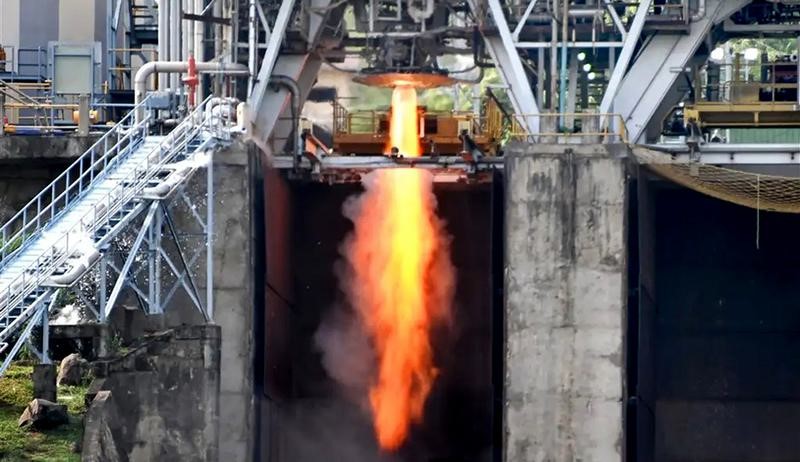Description

Disclaimer: Copyright infringement not intended.
Context
- On February 21, the Indian Space Research Organisation (ISRO) marked a significant milestone by announcing the successful human-rating of the CE-20 rocket engine.
- This indigenous cryogenic engine, developed to power the GSLV Mk III (now LVM-3) launch vehicle, represents a pivotal advancement in India's space program, particularly in the context of the upcoming Gaganyaan mission.
Details
Importance of Liquid Hydrogen Fuel
- Efficiency and Velocity: Engineers opt for liquid fuels, particularly hydrogen, due to their superior flow characteristics and high exhaust velocity upon combustion.
- Comparative Analysis: Hydrogen-oxygen combustion yields exhaust velocities of 4.5 km/s, surpassing those of alternative fuel combinations like unsymmetrical dimethylhydrazine and nitrogen tetroxide (3.4 km/s), making hydrogen the preferred choice for rocket propulsion.
CE-20 Cryogenic Engine
- Indigenous Innovation: Developed by ISRO, the CE-20 engine signifies a leap forward from its predecessor, the CE-7.5 cryogenic engine, enhancing India's self-reliance in space technology.
- Key Enhancements: Designed specifically for human spaceflight missions like Gaganyaan, the CE-20 offers improvements in performance, reliability, and safety critical for crewed missions.
Role in Gaganyaan Mission
- Human-Rating Certification: The successful human-rating of the CE-20 engine paves the way for its integration into the GSLV Mk III, facilitating the upcoming test flight of India's first crewed space mission.
- Instrumental Component: As the primary propulsion system for the LVM-3 launch vehicle, the CE-20 engine is instrumental in achieving the necessary thrust and trajectory for crewed spaceflight operations.

Evolution of Cryogenic Engines in ISRO
- The development of cryogenic engines has been pivotal in advancing India's space program, enabling the efficient utilization of liquid hydrogen as rocket fuel.
- Over the years, the Indian Space Research Organisation (ISRO) has evolved its cryogenic engine technology, transitioning from imported models to indigenous designs such as the CE-7.5 and CE-20.
- This evolution reflects ISRO's quest for self-reliance and technological prowess in space exploration.
The Journey of Cryogenic Engines:
- Introduction of Cryogenic Technology: Liquid hydrogen's unique properties make it an ideal rocket fuel, but its cryogenic nature poses engineering challenges. ISRO embarked on harnessing this technology with the introduction of the KVD-1 engine, supplied by the Soviet Union in the 1980s.
- Indigenous Development: Building on the foundation laid by the KVD-1, ISRO developed the CE-7.5 cryogenic engine, which served as a crucial component in the GSLV Mk II launch vehicle. This engine incorporated the staged-combustion cycle and vernier thrusters for precise control during flight.
- Advancements with CE-20: The CE-20 engine represents a significant leap forward in cryogenic engine technology. Employing the gas-generator cycle, it offers enhanced reliability and simplified construction compared to its predecessor. ISRO's decision to eliminate vernier thrusters in favor of nozzle gimbal control further streamlines the engine's design while maximizing thrust output.
Key Components and Operational Dynamics:
- Cryogenic Engine Components: Cryopumps, storage tanks, and turbopumps are essential elements of cryogenic engines, facilitating the storage and transfer of liquid hydrogen and oxygen. The CE-7.5 engine utilizes a staged-combustion cycle, while the CE-20 engine adopts the gas-generator cycle for improved operational efficiency.
- Operational Contrasts: While both engines serve the common goal of propelling rockets into space, they exhibit distinct operational characteristics. The CE-7.5 engine prioritizes fuel efficiency and weight reduction, while the CE-20 engine emphasizes maximum thrust and simplified design for ease of manufacturing and testing.
Maximizing Reliability:
- Human-Rating Process: Human-rating involves intensive testing to ensure that critical components, such as valves and engines, meet stringent reliability requirements. ISRO's CE-20 engine underwent comprehensive testing to verify its performance and reliability for crewed missions.
- Reliability Standards: NASA's Commercial Crew Program sets stringent reliability standards, requiring the probability of mission loss during ascent or descent to be lower than 1/500 (0.2%). To meet these standards, ISRO conducted extensive testing of the CE-20 engine to validate its reliability under simulated mission conditions.
- Hot-Fire Testing: ISRO conducted hot-fire tests of the CE-20 engine, totaling 8,810 seconds, exceeding the minimum human-rating qualification standard of 6,350 seconds. These tests subjected the engine to combustion and exhaust conditions, ensuring its performance met mission requirements.
Legacy:
- Technological Advancements: The development and successful testing of the CE-20 engine signify a significant technological achievement for ISRO, showcasing its capabilities in indigenous cryogenic propulsion systems.
- Self-Sufficiency and Low-Cost Launches: The CE-20 engine enhances India's self-sufficiency in launch capabilities while maintaining cost-effectiveness. Its utilization in the LVM-3 launch vehicle supports missions ranging from satellite deployment to crewed spaceflight.
- Mission Deployments: LVM-3 rockets equipped with the CE-20 engine have already launched critical missions, including Chandrayaan-2 and -3 lunar missions, as well as commercial satellite deployments such as the OneWeb mission. These successes underscore the engine's reliability and versatility.

Conclusion
The CE-20 cryogenic engine represents a pinnacle of ISRO's technological achievements, serving as a cornerstone of India's space endeavors. Its success underscores India's journey towards self-sufficiency in space propulsion and positions the nation as a formidable player in the global space arena. As ISRO continues to push boundaries and explore new frontiers, the legacy of the CE-20 engine will endure as a testament to India's quest for excellence in space science and technology.
|
PRACTICE QUESTION
Q. The evolution of cryogenic engines from KVD-1 to CE-20 exemplifies ISRO's commitment to innovation and self-reliance in space technology. Discuss. (250 words)
|










